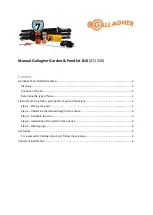
17
Subject to change without notice
Controls and Readout
edge without blanking. The start of the section, which
was previously unblanked in the
”SEA” (SEARCH)
mode,
now lies at the left edge. The display can be expanded in
the X direction by rotating the
TIME/DIV
control
clockwise and thus decreasing the time deflection
coefficient. If a part of the signal of interest goes beyond
the right edge, it can be brought within the screen and
made visible by
DEL.POS
knob. Increasing the time
deflection coefficient beyond that used in the
”SEA”
(SEARCH)
mode is not provided as it is practically
meaningless.
In the untriggered
”DEL” (DELAY)
mode, a trigger event
does not start the trace at once but only starts the delay
time. After the delay time has elapsed the trace is started.
In triggered
DELAY
mode
(DTR)
, to start the sweep, a
signal suitable for triggering must appear after the delay
time. The trace will be started if the instrument settings
(e.g.
LEVEL
setting) enable a triggering.
See
DEL.TRIG.
(31)
.
(25)DEL.TRIG. - VAR.
-pushbutton with two functions.
DEL.TRIG. function
In the case of untriggered
”DEL” (DELAY)
mode,
briefly
pressing
the button switches over to
”DTR”
(triggered
DELAY
mode). Thereby, the previously active settings,
Automatic/normal triggering (10)
, trigger
LEVEL (12)
,
trigger slope (10)
and
trigger coupling (21)
will be sto-
red.
It will be automatically switched to normal triggering and
DC
trigger coupling in
”DTR”
mode. Subsequently the
trigger
LEVEL
setting and the trigger slope should be so
adjusted that the signal for delayed trigger can trigger
the time base. Without triggering the screen will remain
blank.
Briefly pressing the button again switches back to
(untriggered)
DEL.
Operation.
VAR. function
Pressing and holding
the button changes the function
of the
TIME/DIV.
knob.
The
TIME/DIV.
knob can function as a time deflection
coefficient switch (1-2-5 sequence) or as a time vernier
(fine adjustment). The current function is indicated by
the
VAR
-LED. The
TIME/DIV.
knob functions as a vernier
when the
VAR
-LED is switched on, but the time base
setting remains calibrated until the (vernier) knob is
operated. The readout now indicates
”T>...”
instead of
”T:...”.
Rotating further anticlockwise increases the time
deflection coefficient (uncalibrated) until the maximum
is reached indicated by a beep. Rotating the knob
clockwise has the opposite effect. Now, the vernier is
again in the calibrated position and the symbol
” >”
will
be replaced by symbol
” :”
.
The function of the knob can be switched back to normal
(calibrated) time base, pressing and holding the button.
Underneath the front panel sector described above, the
BNC sockets and four pushbuttons are located.
(26) INPUT CH I (X)
- BNC socket.
This BNC socket is the signal input for channel I. The
outer (ground) connection is galvanically connected to
the instrument ground and consequently to the safety
earth contact of the line/mains plug.
In
XY
mode, signals at this input are used for the
X
deflection.
(27) AC / DC
- Pushbutton with two functions.
Input coupling:
Briefly pressing this pushbutton switches over from
AC
(
~
symbol) to
DC
(
=
symbol) input coupling and vice versa.
The setting is displayed in the readout with the deflection
coefficient.
Probe factor:
Pressing and holding the pushbutton selects the indicated
deflection coefficient of channel I displayed in the readout,
between 1:1 and 10:1. In condition 10:1 the probe factor
is thus indicated by a probe symbol displayed by the
readout in front the channel information (e.g.
”probe
symbol”, Y1...
). In the case of cursor voltage measure-
ment, the probe factor is automatically included.
Please note:
The symbol must not be activated unless a x10 (10:1)
attenuator probe is used.
(28)GD
- Pushbutton.
Each time this pushbutton is pressed briefly, the input is
switched from active to inactive and vice versa. It is
displayed in the readout as an earth (ground) symbol
instead of the deflection coefficient and the
~ (AC)
or
=
(DC)
symbol.
The
GD
setting disables the input signal, the
AC/DC (27)
pushbutton and the
VOLTS/DIV (15)
knob. In automatic
trigger mode the undeflected trace is visible representing
the 0 Volt trace position.
(29)Ground socket -
4mm banana socket galvanically con-
nected to safety earth. This socket can be used as refe-
rence potential connection for
DC
and low frequency signal
measurement purposes and in
COMPONENT TEST
mode.
















































